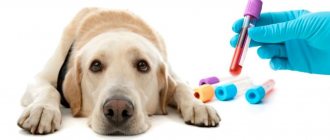Hematemesis or vomiting of blood in a dog is a phenomenon that should alert the pet owner. There may be several reasons for the occurrence of this symptom, but all of them are a characteristic sign of certain disorders in the body. Bloody discharge in vomit most often indicates injury or the presence of a chronic disease.
Timely identification of the main cause of bloody discharge will help cure the dog, and in some cases, save its life.
Types of bloody vomiting in dogs
If the owner notices that the pet is vomiting with blood, then it is necessary to determine the cause of this condition. Thanks to this, you can provide first aid to your pet and make a correct diagnosis. There are several types of this condition:
- Black color with bile in a dog indicates the presence of kidney failure, poisoning or parvovirus type enteritis. The cause may be kidney failure, then diarrhea, anemia and an ammonia smell from the mouth appear with vomiting.
- Brown color is a clear sign of internal gastric bleeding. This condition poses a great danger. If there are several blood clots, then this is the effect of hydrochloric acid of the stomach.
- Scarlet color appears due to injury to internal organs. This includes damage to the esophagus, mouth or pharynx. We must try to examine the pet's mouth, paying attention to the tongue and the area under it.
How to properly care for your dog during recovery
Considering that the causes of vomiting are most often caused by gastrointestinal problems, it will be important to organize a therapeutic fast for a period of 24–48 hours. During this period, the pet can only have drinking water.
Did you know? In obese dogs, inflammatory processes in the gastrointestinal tract are more often diagnosed. Therefore, they are strongly advised to follow a diet.
Then little by little they begin to give food. This is white rice congee or mashed potatoes. The source of protein will be boiled fish or low-fat cottage cheese. Fiber is added later. If there are special instructions for the diet, the veterinarian will definitely explain them.
Causes of vomiting blood in dogs
Excessive vomiting in dogs is a protective mechanism of the body and is not dangerous in itself. But this phenomenon and its cause serve as a signal that the dog needs immediate veterinary help.
There are many reasons for an animal to vomit blood:
- Wrong diet.
- Poisoning. Most often, dogs eat rat poison, which causes bleeding.
- Diseases with blood clotting disorders. These include kidney and liver diseases, severe forms of enteropathy, oncology and mechanical injuries.
- Gastrointestinal ulcers.
- Swallowing objects. A similar chronic condition, where there is a bloody clot, appears when foreign objects enter the stomach, and the walls there are injured.
- Taking medications. The dog vomits when the pet takes non-steroidal drugs with anti-inflammatory effects, medications to reduce platelet levels in the blood.
- Chronic diseases.
- Presence of cancer.
Especially often, bloody vomiting occurs in dogs on the road. This is normal because the vestibular system is disrupted and the pet experiences stress.
What medications can be used?
Medicines from a regular pharmacy will be useful for symptomatic treatment. But if the cause of vomiting blood is, for example, parasites in the intestines, then specific veterinary drugs such as albene and albendazole will be useful. True, pyrantel from a regular pharmacy will also help. In general, omeprazole (1 mg/kg once daily) and pantaprazole (11 mg/kg IV once every 24 hours) would be applicable. They will reduce the acidity of the stomach and its secretory function.
To dull the vomiting spasm, metoclopramide is useful at a dose of 1-2 mg/kg of animal weight once every 24 hours. The use of broad-spectrum antibiotics is indicated - penicillin, fluoroquinolone, cephalosporin.
There is also the practice of using pure medical alcohol. It is injected directly into the ulcer site using an endoscopic sclerotomy needle. Alcohol causes a sharp coagulation of the protein (cauterizes) and thereby heals the ulcer and stops bleeding.
Opioids are recommended for pain relief (in peak cases), but this is costly from a practical point of view in veterinary medicine. The drug no-spa is suitable for these purposes. The drug smecta is also recommended to relieve intoxication. In case of severe exhaustion, droppers from Ringer-Locke solution, Ringer solution, etc. are used.
Important! The antidote (means of counteracting, neutralizing) for poisoning with rat poison is vitamin K (for example, the drug Vikasol) for intramuscular injection in large doses! The higher the concentration, the more positive the therapeutic effect!
Associated symptoms
Of course, if the internal bleeding is not severe, then the pet’s condition can worsen sharply. Such diseases cause great harm to the health of the pet. With the appearance of vomiting, the dog also begins to feel sick, the appetite sharply worsens or may not exist. Due to problems with the digestive system, diarrhea appears along with vomiting. The presence of bloody mucous diarrhea is also not uncommon.
When dogs have liver damage, they have problems with the amount of bilirubin in their body. Yellowness appears on the mucous membranes, and the urine becomes rich yellow and sometimes pink. Infections cause an increase in body temperature. With large blood losses, the body is depleted, which causes a decrease in hemoglobin. And also, along with vomiting, the dog begins to breathe heavily.
If the bleeding is due to parasites, then they can be seen not only in the dog’s feces, but also in the vomit. Often, disturbances also affect the water-elytrolyte balance and metabolic processes. The dog suddenly loses weight, its eyes become sunken and cloudy. The fur also begins to fade and become matted. The animal looks scared, tries to hide in a dark, warm place, and behaves restlessly.
Diarrhea and high fever
The appearance of diarrhea and a sharp change in the dog’s body temperature, along with loss of appetite and bloody brown fluid, are signs of an acute illness with a viral or infectious etiology. If you notice these signs, contact your veterinarian immediately to determine the diagnosis and begin treatment. Diseases of this etiology often lead to the death of the pet or serious complications.
Unpleasant odor from the mouth
There is a huge list of diseases accompanied by vomiting and mouth odor. The presence of diabetes mellitus is indicated by the presence of acetone breath. If your pet has kidney failure, it smells like ammonia from his mouth. Putrefactive - indicates intestinal pathologies. But your pet also suffers from diseases in the oral cavity.
The appearance of bile
Bile also appears in the bloody vomit, which means there may be an intestinal obstruction, a stomach ulcer, or an infectious liver lesion. Worms also cause these symptoms. In the summer, dogs like to eat green grass, which can also lead to the appearance of blood mixed with bile.
Foam
Vomiting foam is not dangerous. But the dog owner is immediately obliged to contact a veterinarian if his pet, in addition to vomiting with foam, also has blood. Bloody vomiting occurs with indigestion or the development of pancreatitis.
Causes
This type of discomfort occurs due to a number of reasons. Almost all of them are quite serious and life-threatening, and the presence of constant nausea indicates an advanced, critical condition in which the dog is. It is also very important to take into account all accompanying symptoms.
Poisoning
One of the most common causes is poisoning by rat poison, arsenic and other compounds similar in their effects on the body. Dog owners often encounter accidental poisonings when the dog eats a dead rodent found or finds bait left by dog hunters on the street. This is a very serious diagnosis, since the animal does not begin to vomit immediately.
An additional indicator of poison penetration is diarrhea. If black spots are observed in the regurgitation, it means that most of the vital organs are no longer working. It is almost impossible to save a pet.
Ulcers in the gastrointestinal tract
Most often it is a stomach or esophageal ulcer, but sometimes the cause is a duodenal ulcer. They can be triggered by poor nutrition or the entry of a foreign sharp body into the stomach. Inflammations are extremely dangerous if you do not seek help in time.
Coagulopathy
A disease characterized by problems with blood clotting and a lack of red blood cells. Most often it is only a complication of a more severe disease. For example, chemical poisoning or kidney disease. It also often develops against the background of mechanical damage to the gastrointestinal tract.
Diagnostics
At an appointment with a veterinarian, you should remember all the moments in the life of your pet recently. The accuracy of the diagnosis and the selection of effective treatment will depend on this. The following methods are used for diagnosis:
- Full examination of the dog. The doctor assesses the general well-being of the animal, listens to the heart rhythm, determines the condition of the mucous membranes, and measures the temperature.
- Anamnesis collection. Answer questions regarding the duration of vomiting, its nature and consistency. Tell your doctor if the bloody, foamy vomit contains bile or mucus.
- Laboratory research. Biochemical and general blood tests, urine collection and stool examination.
- Instrumental diagnostics. A fluoroscopy, endoscopic or ultrasound examination is performed.
Testing vomit where there is a small streak of blood takes a complex approach because history taking and clinical examination do not provide a complete picture of the situation. The use of different diagnostic methods allows us to determine the exact cause of the condition and prescribe appropriate treatment.
Treating diarrhea at home
At the first stage or with diarrhea without significant signs of dehydration and intoxication, the owner helps the pet at home. Give your dog water in small quantities but often.
To relieve pain in the intestines caused by spastic contractions of the smooth muscles of the intestines, inject the dog intramuscularly with a solution of papaverine or no-shpa. Veterinarians advise using medications in tablet form as prescribed by a doctor.
Give us sorbents - enterosgel, smecta, activated carbon. If there are signs of dehydration, the animal is soldered with saline solutions such as rehydron and glucose solution. This helps stop vomiting and diarrhea. If drinking is ineffective, hydration can be achieved using intravenous drips.
To relieve inflammation, it is recommended to give the dog small portions of oak bark decoction. Enveloping properties and tannins (pectins, antioxidants) help counteract putrefactive processes, destroying microbes and relieving inflammation.
To restore normal intestinal microflora, offer your dog probiotics - Lactobacterin, Bifidobacterin, Bifiform. Further, it is possible to give fermented milk products.
Treatment options
Vomiting blood in a dog does not go away on its own, without the intervention of a veterinarian. Contact your doctor immediately if you notice the above symptoms and signs. The diagnosis is made by a doctor, and the owner helps him. The dog owner provides detailed information about diet, behavior, frequency of vomiting and other symptoms.
Based on the results of the examination and research, a course of treatment is prescribed. Treatment is carried out at home. Nutrition is also adjusted and rehabilitation therapy is prescribed. Caring for the animal must be thorough.
What to do
If your pet’s nausea was a one-time occurrence, then there is no need to worry. This could happen during self-cleansing of the stomach, as a defensive reaction, for example, when swallowing a foreign object, say, a thread, or after eating a herb that causes stomach cleansing.
In this case, it is necessary to carefully examine the mucus and make sure that the cause of its release was a foreign object or grass.
If nausea and vomiting systematically bother the animal, then it should be immediately shown to a doctor, as these signs indicate the possible presence of a disease in the dog.
First aid for a pet
What to do when you notice an attack of vomiting? At the first sign, remove the muzzle and collar to prevent your pet from suffocating during an attack. Before contacting a specialist, provide first aid to your dog. This will help reduce irritation of the gastrointestinal mucosa. Give water in small quantities under the conditions that sips should be small. If it is not yet possible to contact a veterinarian, then give Kvamatel, which will alleviate the condition.
Perhaps the cause was poison, then within 2 hours, administer hydrogen peroxide 1–2 ml/kg, give a subcutaneous injection of vitamin K1, and give sorbents. If after an attack the dog has chills, then you need to cover it with a warm blanket and just sit with it. Try giving your pet some chicken broth 3-4 hours after the last vomiting.
Never scold your dog, even if it vomits on your favorite carpet. Vomiting is an involuntary phenomenon, and the pet simply cannot run to the toilet.
When veterinary help is urgently needed
Therefore, let’s immediately figure out when you shouldn’t engage in “self-medication”, but you need to immediately call a veterinary specialist:
- More than half of the vomit consists of bloody matter or pure blood.
- In cases where the blood is bright scarlet.
- Pets who are vomiting foamy, bright red blood also need a veterinarian as quickly as possible. This almost always indicates massive pulmonary hemorrhage. If the pet is not helped, it may die from asphyxia (suffocation).
- Hospitalization is immediately required if all visible mucous membranes of the pet become noticeably pale and/or blue. This indicates massive blood loss.
- You also need to immediately help a dog that, in the presence of bloody vomiting, becomes weak, has difficulty moving, whines weakly or in some strange way, and shows other obvious signs of serious illness.
Medications
After the doctor has established an accurate diagnosis, complex drug treatment is prescribed. This includes:
- Antiemetics.
- Antispasmodics.
- Hemostatic.
- Sorbents.
The main condition: you should never select medications yourself!
To eliminate spasms and pain in the stomach, No-shpa is prescribed, and if the stomach is to blame, then Omez will help. Smecta or Polysorb are most often prescribed as a sorbent.
To eliminate the causes of vomiting, it is possible to prescribe antibiotics, anthelmintic drugs and non-steroidal medications. Upon the onset of remission, vitamins and homeopathy are prescribed to restore the weakened body.
In cases of severe dehydration, intravenous drips are used to restore lost fluid in a dog.
The dosage is prescribed by the doctor. An incorrect dosage will lead to poisoning of the body and increased vomiting.
Folk remedies and nutrition
Sometimes auxiliary therapy is based on folk remedies. The walls of the stomach are perfectly protected with a decoction of flaxseed. When the dog’s vomiting goes away, you can use a mint decoction. It helps to relax the stomach muscles and prevent further episodes of nausea. Decoctions of dill, lemon balm and chamomile seeds help well with intestinal diseases.
Be sure to put your dog on a diet as soon as the vomiting stops. Feed your pet small portions. Dogs are allowed to eat low-fat cottage cheese, liquid rice water, oatmeal, and yogurt. It is better to feed your dog 5-6 times a day.
Warning signs of vomiting
If the owner is near the pet, he will be able to notice that the dog is vomiting.
Vomiting is always preceded by the following signs:
- the animal behaves restlessly;
- he began to drool profusely;
- Swallowing movements became more frequent.
If you look at the dog’s stomach, you will notice that muscle contractions have been added to the rapid breathing.
These movements are needed to increase internal pressure in the abdominal cavity in order to squeeze its contents out of the stomach (a protective reflex inherent in nature). When the esophageal sphincter weakens, vomit is expelled into the oral cavity. This moment is accompanied by bubbling sounds. The dog's neck involuntarily stretches, causing the head to throw back.
Prevention
If your pet has a strong immune system, bloody vomiting is almost impossible. The health of an animal depends on adequate nutrition, proper care, maintenance and the availability of required physical activity, taking into account the breed of the dog.
Meals should be regular and on schedule. The absence of symptoms is not a valid reason for skipping vaccinations. Deworm regularly. On the street, do not allow your dog to pick up lying objects and this will help avoid poisoning. You should not give bones with sharp edges to your pet, and it is also recommended to avoid crumbling bones.
Constantly monitor your dog's health, especially when there are problems with it. The presence of chronic diseases is the reason; it entails the weakening of the dog, and subsequently, hematemesis. This is especially important for a puppy. Give vitamins, various nutritional supplements, dietary supplements regularly. For food, use high-quality food and only licensed food. Make sure your dog does not swallow foreign bodies.
Care after stopping vomiting
After a fasting diet, you should apply a gentle diet for 5-7 days. Give the animal food only in small portions and preferably at regular intervals, at the same time. Try not to disturb your pet again and eliminate any physical effort. Take him out for a walk for 10-15 minutes.
It is very important to use all the medications that are prescribed to treat your dog, and in no case should you interrupt the course prescribed by the veterinarian, or extend it yourself.
Closely monitor the patient’s general condition and inform the doctor if there is the slightest deterioration. Carry out thermometry at least 2-3 times a day. Avoid contact with other animals if possible. Don't expose your dog to stress!
conclusions
Vomiting blood is a serious symptom and requires immediate treatment and diagnosis of the causes of this condition. There are many factors for the development of this condition - from ulcers to injuries and taking the wrong foods. Contact a specialist in a timely manner and do not delay starting therapy, because in the absence of treatment, diseases that cause hematemesis become chronic.
And also the one-time appearance of bloody vomiting is a signal for an immediate comprehensive examination of your pet.











